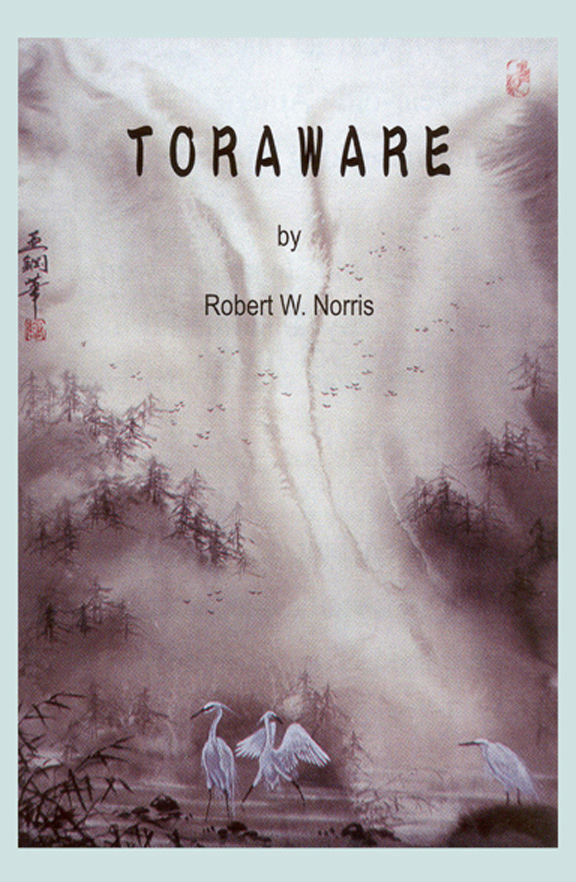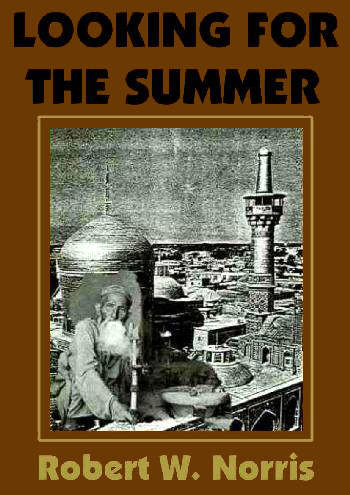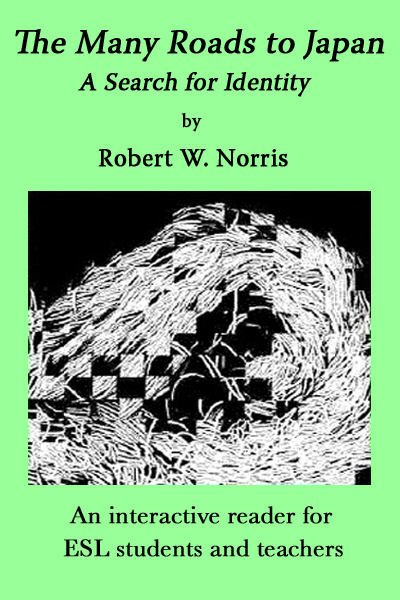
Home About Robert CV The Good Lord Willing and the Creek Don't Rise: Pentimento Memories of Mom and Me Novels Reviews ESL Papers (can be viewed online by clicking on titles) The Many Roads to Japan (free online version for ESL/EFL teachers and students) Contact     |
Robert W. Norris 1994. In Fukuoka Women's Junior College Studies Vol. 48: 25-38 Introduction
For several years I have often observed Japanese college students, when doing homework for literature and reading classes, engaged in a laborious, time-consuming, and seemingly painful (judging from the looks on their faces) task of word-by-word translation of the text. Whenever I have asked if they enjoyed what they were doing, the students' response has usually been an immediate "no!" These students have obviously been putting in a lot of time and effort out of which they have reaped little, if any, reward. Throughout their formal English education history stretching from junior high school to college, their exposure to reading and literature has been dominated by lectures in which the teachers dictate their own interpretations of plot, theme, characters, and semantic meaning, and have the students perform, for homework, word-by-word translation exercises to which the teachers are the only judges of correctness. The whole process seems inefficient and ineffective to me. Surely there must be an alternative. When asked last year to teach a modern American literature course, I jumped at the opportunity. My experiences have proven to me that, with a little imagination and variety on the teacher's part, Japanese college and university students can learn to relax and enjoy the reading process, and to become more personally involved with the texts they read, more independent and motivated, and more efficient and effective readers. This first paper of a two-part series examines the deficiencies of word-by-word translation and lecture-dominated teaching methods, summarizes current research on ESL/EFL (English as a second or foreign language) reading and how it applies to Japanese students of English, and gives suggestions on how to improve the teaching of English reading and literature at Japanese colleges and universities. The second paper will follow up with a detailed report on the planning, actual teaching, and results obtained in a one-semester literature class I was allowed to teach to second-year English majors at Fukuoka Women's Junior College. What's Wrong
with the Yakudoku
Method?
Before answering this question, it is essential to first understand exactly what yakudoku is. Yaku in Japanese means "translation," and doku means reading. Hino (1988: 46) defines yakudoku as:
There are numerous disadvantages to the Yakudoku Method. Ueda (1979) says that it results in regressive eye movement and meaning is not understood directly in the target language. Hino (1988: 47) claims it "limits the speed at which the student reads, induces fatigue, and reduces the efficiency with which s/he is able to comprehend." The Yakudoku Method is also said to have a bad effect on the other language skills of listening, speaking, and writing. Japanese students often have a tendency to use a similar word-by-word strategy when listening to spoken English. Hino (1988: 47) states that students trained in yakudoku reading try to understand speech by translating every word into Japanese, which results in their not understanding unless the speaker speaks slowly. These students, according to Hino (1988: 47), find comprehension a "tiring, imprecise, and ineffective process." In speaking and writing, the yakudoku process is applied in reverse, with a Japanese sentence being translated word-by-word into English and reordered according to English syntax (Matsumoto, 1965). Even if Japanese students manage to build up a large vocabulary, the habit of reading word by word is still a laboriously ineffective way of reading. Eskey and Grabe (1988: 233-234) point out that this strategy destroys students' chances of comprehending very much of the text.
Teacher-Dominated
Lectures
Willis (1993: 91-92), in recounting his experiences as an exchange student at a Japanese university, describes what might be a typical literature class in Japan.
Long (1986: 42) believes in the importance of involving students with the text.
Reading Models
and Their Implications
Several models of the reading process have been developed over the years to explain how a reader derives meaning from a text. Early research in second language reading (in particular, English as a second language) assumed it was a passive, bottom-up process. Carrell 1988: 2) explains:
Goodman's psycholinguistic theory saw the reader as an active participant in the reading process. ESL researchers latched on to this view and top-down reading models were the rage of the 1980s. Carrell (1988: 4) explains the top-down view of second language reading:
One way of manipulating the text
can be done by confining reading to a single topic
or works by a single author. Krashen (1981) calls
this "narrow reading." The advantages of narrow
reading include:
Manipulating the reader means providing background information and previewing content. Carrell and Eisterhold (1988: 87) say that students should not have to read the material "cold,* and that "asking the students to manipulate both the linguistic and cultural codes is asking too much." The introduction of a top-down processing perspective into second language reading has had such a profound influence on the field that there has been a tendency to view this perspective as a substitute for the bottom-up, decoding view of reading rather than its complement. Not all researchers, however, have jumped on the top-down bandwagon. Eskey (1988: 95), for example, thinks that "much of the second language reading literature continues to exhibit a strongly top-down bias." By this, Eskey (1988) means that during the past 20 years of the "top-down revolution," researchers have focused almost exclusively on such concerns as the role of culture-specific assumptions or subject-matter schema. This research, in Eskey's (1988) opinion, has resulted in many useful insights, but the lack of attention to decoding problems has produced a slightly distorted picture of the true range of problems second language readers face. Eskey's (1988) view has particular relevance for Japanese college and university students with their strong grounding in yakudoku, word-by-word translation strategies. Few of these students are able to rely on top-down strategies, and most are still limited to using strictly bottom-up processing skills such as identification of vocabulary and grammatical forms. Eskey and Grabe (1988: 224) believe a truer model of the reading process should "maintain the strengths of a top-down model and, at the same time, provide a way to address such questions as...how and to what degree literate second language readers employ lower-level processing skills and how those interact with higher-level strategies...." Eskey and Grabe (1988: 224) call for a model that (a) assumes that skills at all levels are interactively available to process and interpret the text and that (b) subsumes both top-down and bottom-up strategies. This model would incorporate the use of background knowledge, expectations, and context, and, at the same time, the notions of rapid and accurate recognition of linguistic units. This model implies that for second language readers both top-down and bottom-up skills and strategies must be developed jointly since both contribute directly to the successful comprehension of the text. Eskey and Grabe (1988: 227) recommend doing this in the following two ways:
Hino (1988: 53), for example, believes "pedagogy for teaching English in Japan should put its first priority on helping students overcome the yakudoku habit." Rivers (1981: 273) agrees:
What Should Our
Goals Be?
Eskey (1990: 24), in reviewing past research on the reading process and current research on reading behavior, suggests that the reading teacher's job lies in motivating students to read and facilitating the reading process for them. Simply stated, this means helping students learn to enjoy reading, and making reading in English easier for them. If it is agreed that teacher can motivate students by getting them more personally involved with what they are reading, then it follows that teachers should step down from their lecture podiums and begin encouraging students to respond on their own to what they read. Wright (1993: 4) says teachers of literature should "alter our stance so that we infect [students] with a love of literature for its own sake, not as a reservoir of facts to be assimilated, nor as the hackwork of a dry, academic discipline." Many teachers at Japanese colleges and universities might oppose Wright's (1993) opinion by claiming that Japanese students are not able to interpret literary texts due to linguistic deficiencies and a lack of understanding cultural differences. It is, therefore, the responsibility of teachers to impart this knowledge and do the interpreting. Furthermore, the Japanese teachers may claim the language of literature is too difficult for the students, and that the students need an intermediary. In response to the first claim, Leki (1986) strongly urges that linguistic deficiencies and cultural differences not lead teachers to interpret the text for students. Leki (1986: 8) says, "Accuracy does not make up for or match what the students get if they have a direct, personal experience of literature, a real personal interaction." Collie and Slater (1987) also believe students should explore their own responses to literature. According to Collie and Slater (1987: 9), by using group work and tapping the resources of knowledge and experience within the groups, activities and tasks centered on a literary text help students "acquire the confidence to develop, express, and value their own response," as well as "become less dependent on received opinion and therefore interested in and more able to assess other perspectives." Collie and Slater (1987: 9) also believe that students who engage in such group work may come to be more familiar with the text itself.
Group Work Once the teacher has decided to involve the students more personally and to make them more responsible for their own learning, how can the teacher facilitate the process? The obvious answer, particularly in Japan where large classes are the norm, lies, as suggested by Collie and Slater (1987), in group work built around task-based activities. Group work has many advantages. It gives the students the opportunity to relate their own lives, activities, and interests and concerns to the second language and to what is being read in the second language. The students also have the opportunity to work together and learn from one another. Papalia (1987: 78) explains:
Collie and Slater (1987) list a variety of ways group work can be used in a literature class. Role-play, improvisation, creative writing, discussions, visuals, and other activities normally used to vary and liven up other classes can serve similar purposes in literature classes. Working with a group lessens the difficulties presented by the number of unknowns on a page of literary text. Shifting attention away from the text itself to shared activity helps create a risk-taking atmosphere in which the individual, with the group's support and control, has greater freedom to explore his or her own reactions and interpretations. Collie and Slater (1987: 9) urge teachers to "exploit as fully as possible the emotional dimension that is a very integral part of literature." What Specific
Activities?
Taking into consideration Japanese college and university students' yakudoku reading habits, their heavy reliance on dictionaries and teachers' explanations, and their general lack of top-down English reading skills, the teacher needs to design activities that give balance to both improving bottom-up skills and introducing top-down skills. One type of activity that helps students to learn to read in meaningful segments (as opposed to word-by-word translation) and persevere with the text in the expectation that later reading will explicate what has not been understood (as opposed to constant reference to a dictionary) is a timed reading where the students complete a worksheet. The worksheet can be a list of true-false questions, a jumbling of the order of events that must be put in correct order, or a list of multiple-choice questions. The students first do the work individually. At the end of the time limit, they compare and discuss answers with other members of their group, and, under a new time limit, compromise and hand in a group answer sheet to the teacher. In a similar activity, worksheets with one list of adjectives describing physical features or personality traits and another list of characters' names are handed out. Students must match these features and traits with the characters, as well as find the page and line numbers of the sentences describing the characters. If, for example, there are five characters in the story, groups of five can be formed with each member responsible for a different character. The students discuss and collate their results onto one answer sheet. A "word search" activity involving the entire class is easily done. In a class for, say, 50 students, the teacher selects 25 key vocabulary items and writes each one on a separate card with a corresponding card containing a simple definition. He mixes up the 50 cards and distributes them among the students, who have to find their matching partner. When a pair matches up, the two students go in search of other pairs, sharing the vocabulary and definitions with each new pair. When all 25 matches are found, the students return to their groups to search the text for sentences containing the vocabulary. They write the sentences on a group paper to be handed in. One option is to have the students create their own sentences with the new vocabulary. Pre-reading activities are also useful and motivating. In one such activity the teacher determines two or three issues that emerge in the text and prepares a question or two for each issue. The questions should require the students to search through their own lives for similar experiences, but do not need to be elaborate. The purpose is simply to stimulate within each student a set of associations that will make the student receptive to the possibilities that may be explored in the text. This makes a good homework assignment for the first class. At different points during the reading of the text, handouts with predictions to be made about characters' actions or development in the story can be given to the students. Groups discuss under a time limit, answer the questions, and give the handout back to the teacher. A simple reason should be given for each prediction. For lower-level students it is better to give three or four possibilities to choose from than to give open-ended questions. The handouts can later be returned to the students to see how accurate their predictions were. Upon completion of the story, students can be asked to discuss in groups alternative endings, write their own, and give them to the teacher. For either pre- or post-reading activities videos or cassette tapes, where available, can be used to provide meaningful support and clarification of what the students are reading. Stempleski (1990: 3) highly recommends the use of video.
These are just a few of innumerable exercises that involve the entire class and make reading and the study of literature a more enjoyable and productive process. Many other ideas for activities easily adapted to Japanese college and university classrooms can be found in Collie and Slater (1987) and Papalia (1987). Conclusion
In recent years, research into reading processes clearly shows that the old Yakudoku Method is outdated and marked by too many deficiencies. It does have a few merits, but they provide too little motivation to too few students. Hino (1988: 52) admits that "the decoding and deciphering activities involved in the yakudoku process provide the learner with opportunities for mental training." Rivers (1981: 30) says that, for highly intellectual students interested in abstract reasoning, grammar-translation teaching can give some benefits.
All too often students are asked to interpret theme, plot, and character in line with what the teacher has told them. Leki (1986: 8) says that in such teacher-dominated classes if the students' ideas are in opposition to or not in keeping with the teacher's own interpretation, the students "are likely to dismiss the author or text as impenetrable, hermetic, and irrelevant because they tried to understand the work and were told they did not." Leki (1986: 8) believes students should be allowed to personalize the reading experience in order to promote a longer-term goal of encouraging students to read on their own for the pleasure of reading.
The type of teaching outlined in this paper--namely, getting away from translation exercises and a teacher-centered lecture format, using texts that are related to students' lives and concerns and can be completed within a particular time frame, and using group activities that involve the students personally and are aimed at improving bottom-up skills as well as top-down skills--provides a viable alternative to the old-fashioned methods still being used to teach literature and reading in many Japanese colleges and universities. The second paper of this series will detail a class taught in the manner prescribed here and will look at both the successes and failures of that class. REFERENCES
Brumfit, C. J. & Carter, R. A (Eds.). 1986. Literature and Language Teaching. Oxford: Oxford University Press. Carrell, P. 1988. Introduction: Interactive approaches to second language reading. In P. Carrell, J. Devine, & D. Eskey (Eds.), Interactive Approaches to Second Language Reading (pp. 1-7). Cambridge: Cambridge University Press. Carrell, P., Devine, J., & Eskey, D. (Eds.). 1988. Interactive Approaches to Second Language Reading. Cambridge: Cambridge University Press. Carrell, P. & Eisterhold, J. 1988. Schema theory and ESL reading pedagogy. In P. Carrell, J. Devine, & D. Eskey (Eds.), Interactive Approaches to Second Language Reading (pp. 73-92). Cambridge: Cambridge University Press. Collie, J. & Slater, S. 1987. Literature in the Language Classroom. Cambridge: Cambridge University Press. Eskey, D. 1988. Holding in the bottom: An interactive approach to the language problems of second language readers. In P. Carrell, J. Devine, & D. Eskey (Eds.), Interactive Approaches to Second Language Reading (pp. 93-100). Cambridge: Cambridge University Press. Eskey, D. 1990. Second language reading for the '90s. The Language Teacher 14(9): 23-25. Eskey, D. & Grabe, W. 1988. Interactive models for second language reading: Perspectives on instruction. In P. Carrell, J. Devine, & D. Eskey (Eds.), Interactive Approaches to Second Language Reading (pp. 223-238). Cambridge: Cambridge University Press. Goodman, K. S. 1967. Reading: A psycholinguistic guessing game. Journal of the Reading Specialist 6(1): 126-135. Goodman, K. S. 1971. Psycholinguistic universals in the reading process. In P. Pimsleur & T. Quinn (Eds.), The Psychology of Second Language Learning (pp. 135-142). Cambridge: Cambridge University Press. Goodman, K. S. 1973. Analysis of oral reading miscues: Applied psycholinguistics. In F. Smith (Ed.), Psycholinguistics and Reading (pp. 158-176). New York: Holt, Rinehart, and Winston. Hino, N. 1988. "Yakudoku: Japan's dominant tradition in foreign language learning." JALT Journal 10(1 & 2): 45-55. Kakita, N. 1978. "Yakudokushiki kyojuho." In Eigokyojuho Kakuron (pp. 16-133). Tokyo: Kenkyusha. Koike, I., et al. 1983. General Survey of English Teaching at Colleges and Universities in Japan: Students' View. Tokyo: Research Group for College English Teaching in Japan. Koike, I., et al. 1985. General Survey of English Teaching at Colleges and Universities in Japan: Students' View. Tokyo: Research Group for College English Teaching in Japan. Krashen, S. D. 1981. The case for narrow reading. TESOL Quarterly 15(2): 23. Leki, V. 1986. Teaching literature of the United States to nonnative speakers. English Teaching Forum 24(1): 2-8. Long, M. N. 1986. A feeling for language: The multiple values of teaching literature. In C. J. Brumfit & R. A. Carter (Eds.), Literature and Language Teaching (pp. 42-59). Oxford: Oxford University Press. Matsumoto, T. 1965. Eigo no Atarashii Manabikata. Tokyo: Kodansha. Papalia, A. 1987. Interaction of reader and text. In W. M. Rivers (Ed.), Interactive Language Teaching (pp. 70-82). Cambridge: Cambridge University Press. Reinelt, R. 1988. Generally addressed question in large classes. The Language Teacher 12(12): 15-18. Rivers, W. M. 1981. Teaching Foreign-Language Skills (2nd ed.) Chicago: University of Chicago Press. Rivers, W. M. (Ed.) 1987. Interactive Language Teaching. Cambridge: Cambridge University Press. Smith, F. 1983. Understanding Reading: A Psycholinguistic Analysis of Reading and Learning to Read(3rd ed.). New York: Holt, Rinehart, and Winston. Stempleski, S. & Wood, D. J. 1990. Interview: Susan Stempleski. The Language Teacher 14(11): 3-4. Tajima, K. 1978. The grammar-translation method: Its historical and social background. In I. Koike, M. Matsuyama, Y. Igarashi, & K. Suzuki (Eds.), The Teaching of English in Japan (pp. 220-227). Tokyo: Eichosha. Ueda, A. 1979. Chokudoku chokkai. In Yomu Eigo (pp. 78-103). Tokyo: Kenkyusha. Wadden, P. (Ed.). 1993. A Handbook for Teaching English at Japanese Colleges and Universities. Oxford: Oxford University Press. Willis, M. 1993. What is the moral of the story? Teaching literature to English majors. In P. Wadden (Ed.), A Handbook for Teaching English at Japanese Colleges and Universities (pp. 91-98). Oxford: Oxford University Press. Wright, R. L. 1993. Teaching literature: A West African perspective. English Teaching Forum 31 (2): 2-5. |